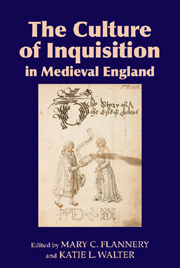Book contents
- Frontmatter
- Contents
- Illustrations
- List of Contributors
- Acknowledgements
- Abbreviations
- Introduction: Imagining Inquisition
- 1 Inquisition, Public Fame and Confession: General Rules and English Practice
- 2 The Imperatives of Denunciatio: Disclosing Others' Sins to Disciplinary Authorities
- 3 English Provincial Constitutions and Inquisition into Lollardy
- 4 The Contest over the Public Imagination of Inquisition, 1380–1430
- 5 ‘Vttirli Onknowe’? Modes of Inquiry and the Dynamics of Interiority in Vernacular Literature
- 6 From Defacement to Restoration: Inquisition, Confession and Thomas Usk's Appeal and Testament of Love
- 7 Confession, Inquisition and Exemplarity in The Erle of Tolous and Other Middle English Romances
- 8 Heresy Inquisition and Authorship, 1400–1560
- 9 Imitating Inquisition: Dialectical Bias in Protestant Prison Writings
- 10 Response Essay: Chaucer's Inquisition
- Bibliography
- Index
Introduction: Imagining Inquisition
Published online by Cambridge University Press: 05 April 2013
- Frontmatter
- Contents
- Illustrations
- List of Contributors
- Acknowledgements
- Abbreviations
- Introduction: Imagining Inquisition
- 1 Inquisition, Public Fame and Confession: General Rules and English Practice
- 2 The Imperatives of Denunciatio: Disclosing Others' Sins to Disciplinary Authorities
- 3 English Provincial Constitutions and Inquisition into Lollardy
- 4 The Contest over the Public Imagination of Inquisition, 1380–1430
- 5 ‘Vttirli Onknowe’? Modes of Inquiry and the Dynamics of Interiority in Vernacular Literature
- 6 From Defacement to Restoration: Inquisition, Confession and Thomas Usk's Appeal and Testament of Love
- 7 Confession, Inquisition and Exemplarity in The Erle of Tolous and Other Middle English Romances
- 8 Heresy Inquisition and Authorship, 1400–1560
- 9 Imitating Inquisition: Dialectical Bias in Protestant Prison Writings
- 10 Response Essay: Chaucer's Inquisition
- Bibliography
- Index
Summary
Inquisitio, a process first codified in the canons of the Fourth Lateran Council of 1215, was an important means of investigating crime in general and heresy in particular in the later medieval period. For the most part, it has been the subject of historical rather than cultural investigation: scholars have focused on its role in the development of the medieval church and its laws, and on the dynamics of heresy inquisition in medieval Europe and, more recently, England. To view it only as a tool in the fight against heresy, however, is to overlook both its broader significance and its imbrication with other mechanisms of medieval canon law. Even in the English ecclesiastical courts, inquisitio had other uses: it was, for example, most commonly used to regulate sexual relations (fornication, adultery, bigamy, etc.); it was bound up with sanctions like excommunication and public penance, as well as confession, sacramental or otherwise; and, perhaps most significantly, since the law stipulated that inquisitio could only be initiated when someone was widely held to be guilty of a specific crime, it was intimately associated with questions of reputation and social standing. It is hardly surprising then that in the centuries following Lateran IV, the applications of inquisition moved beyond the boundaries of the ecclesiastical courts into the fields of exemplarity, rhetoric and poetry.
- Type
- Chapter
- Information
- The Culture of Inquisition in Medieval England , pp. 1 - 7Publisher: Boydell & BrewerPrint publication year: 2013

